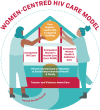Dissemination of the Women-Centred HIV Care Model: A Multimodal Process and Evaluation
- PMID: 38389331
- PMCID: PMC10894538
- DOI: 10.1177/23259582231226036
Dissemination of the Women-Centred HIV Care Model: A Multimodal Process and Evaluation
Abstract
Background: Using data from a national cohort study and focus groups, the Women-Centred HIV Care (WCHC) Model was developed to inform care delivery for women living with HIV.
Methods: Through an evidence-based, integrated knowledge translation approach, we developed 2 toolkits based on the WCHC Model for service providers and women living with HIV in English and French (Canada's national languages). To disseminate, we distributed printed advertising materials, hosted 3 national webinars and conducted 2 virtual capacity-building training series.
Results: A total of 315 individuals attended the webinars, and the average WCHC knowledge increased by 29% (SD 4.3%). In total, 131 service providers engaged in 22 virtual capacity-building training sessions with 21 clinical cases discussed. Learners self-reported increased confidence in 15/15 abilities, including the ability to provide WCHC. As of December 2023, the toolkits were downloaded 7766 times.
Conclusions: We successfully developed WCHC toolkits and shared them with diverse clinical and community audiences through various dissemination methods.
Keywords: HIV; community-based research; healthcare tool; healthcare training; knowledge dissemination; knowledge translation; model of care; women-centred HIV care.
Plain language summary
A study on creating and sharing a toolkit for healthcare providers and women living with HIVWhy was the study done?:The research team created the Women-Centred HIV Care (WCHC) model to help healthcare providers deliver personalised and thorough care to women living with HIV in Canada. This study aimed to develop a practical toolkit based on the model. The goal was to share this toolkit with women and their providers in various ways to get feedback on its usefulness and to understand the best methods for sharing tools in the future.What did the researchers do?:Through an in-depth, collaborative process, English and French WCHC toolkits were developed by a large and diverse team of women and providers. Various methods including printed materials, national webinars and virtual trainings were used to share the toolkits across Canada. The team assessed the toolkit's reception by using surveys, focus groups and tracking toolkit downloads and webpage views.What did the researchers find?:The study found positive results, including a 29% increase in WCHC knowledge for 315 webinar participants and enhanced confidence in 15 abilities for 131 service providers during virtual training. The toolkits were downloaded 7766 times, indicating broad interest. Usability testing showed that the toolkits were easy to use and helpful. Attendees of the webinars and virtual trainings indicated they were likely to use the toolkit and recommend it to others.What do the findings mean?:Overall, the WCHC toolkits offer valuable guidance to women living with HIV and their providers. The study improved providers’ knowledge and confidence in delivering WCHC, especially during the virtual training sessions that focused on applying this knowledge to real clinical cases. During months when the toolkit was shared through printed materials, webinars and virtual training, more people visited the toolkit webpage. The study highlighted the importance of involving those who will use healthcare tools from the beginning and using many ways to share these tools to reach more people.
Conflict of interest statement
Declaration of Conflicting InterestsThe author(s) declared no potential conflicts of interest with respect to the research, authorship and/or publication of this article.
Figures
References
-
- Public Health Agency of Canada. Estimates of HIV, prevalence and Canada’s Progress on meeting the 90-90-90 Targets, 2020. 2022.
-
- World Health Organization. Consolidated guideline on sexual and reproductive health and rights of women living with HIV. 2017. - PubMed
Publication types
MeSH terms
Grants and funding
LinkOut - more resources
Full Text Sources
Medical
Research Materials






